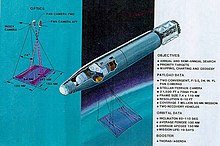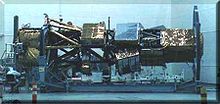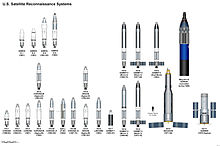Reconnaissance satellite


A reconnaissance satellite is a satellite in space that is equipped with high-resolution optical cameras , radar or other sensors in order to observe the surface of the earth or to listen in on radio communications .
purpose
Reconnaissance satellites are earth observation satellites that are primarily used for military purposes. The images and data obtained are evaluated in order to obtain information about the armed forces of foreign countries such as troop movements, troop strength, combat operations or the like. Natural disasters and civil accidents can also be observed using these satellites.
In order to achieve the highest possible resolution of the target area, reconnaissance satellites are lowered to a lower orbit for observation and then raised again later. This approach is very expensive and severely limits the life of the chemically powered satellites . However, it is the main reason for the difference in quality to civil earth observation satellites, some of which are available on the free market.
Resolving power
The resolving power of a satellite describes the distance between two points (at a given distance from the satellite) at which the satellite can just barely recognize them as separate points. The limitation of the resolution is based on the interference between the light waves emanating from the individual points. Even if the resolving power of military reconnaissance satellites is kept secret, at least some approximate values can be calculated. The most important point is the opening or main mirror diameter, which can be derived from the payload fairing of the launcher, among other things. Due to the diffraction of the main mirror of the optics, the resolution is physically limited. American reconnaissance satellites launched in 1994 and 1995 use parabolic antennas with a diameter of 150 cm.
The following formula calculates the theoretically possible resolution of the satellite optics:
- Resolution calculations using the example of the KH-11 satellite
Wellenlänge des sichtbaren Lichts: 5,5 · 10−5 cm. Spiegeldurchmesser des KH-11 (nach Jeffrey Richelson): 234,0 cm Perigäumshöhe: ~ 300 km = 3 · 107 cm. → Auflösung: 8,6 cm aus 300 km Höhe
With an assumed mirror diameter of 4 m (assumption for the currently maximum possible mirror diameter) the resolution is approx. 5 cm. Due to atmospheric disturbances, the resolution deteriorates compared to the calculated value.
Overview
| Surname | country | Sensors |
|---|---|---|
| lacrosse | United States | Radar ( radio ) |
| SAR magnifying glass | Germany | radar |
| Helios 1 and 2 | France | Optical ( visible and thermal radiation ) |
| Keyhole (KH) | United States | Optically |
| Ofeq 3, 4, 5 and 6 | Israel | Optical (visible and UV radiation ) |
| ORS-1 | United States | Optical (warmth) |
| Vela | United States | EM radiation ( gamma , x-ray and neutron radiation ) |
| IGS | Japan | Optical and radar |
| KOMPSAT-3 , KOMPSAT-3A , KOMPSAT-5 | South Korea | Optical and radar |
| RORSAT | Soviet Union | radar |
literature
- Pat Norris: Spies in the Sky - Surveillance Satellites in War and Peace. Springer, New York 2007, ISBN 978-0-387-71672-5 .
- William E. Burrows: Deep black - space espionage and national security. Random House, New York 1986, ISBN 0-394-54124-3 .
- Thomas Graham, Keith A. Hansen: Spy satellites - and other intelligence technologies that changed history. Univ. of Washington Press, Seattle 2007, ISBN 978-0-295-98686-9 .
- Josef Gerner: Information from space - the new dimension of combat. Mittler, Herford 1990, ISBN 3-8132-0336-0 .
Web links
- Satellite Imagery
- Joby Warrick: Domestic Use of Spy Satellites To Widen - Law Enforcement Getting New Access To Secret Imagery . In: Washington Post , August 16, 2007. ( In the USA, the use of spy satellites is also to be expanded internally; see Homeland Security )
Individual evidence
- ↑ Rainer Paul: Armor: Tandem of the sky scouts . In: Der Spiegel . No. 42 , 1997 ( online ).
- ↑ Anatol Johansen Huge eavesdroppers in the sky . In: Die Zeit , No. 31/1995
- ↑ Ted Molczan: Keyhole resolution .



